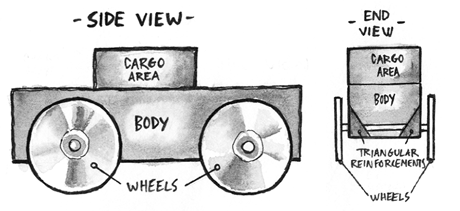The Great Robot Race
|  |
Student Handout
|
Vehicle Construction
The car in the diagram below consists of two axles mounted with four wheels. The power source is the rubber band wound around the axle. Winding up the wheels (in reverse so they will create a forward motion when released) winds the rubber band thereby storing potential energy. When released, the rubber band spins the axle and the wheels.


Construction Hints
Small triangular pieces of cardboard used to reinforce the connection
between the sides and floor of the vehicle will greatly increase strength for
little additional weight. Glue will need to set overnight, so try to do all gluing at least a day
before final testing. Creasing the cardboard will make it resistant to bending at right angles
to the crease. This adds strength for no increase in weight. How far the car travels is dependent on how much energy is stored in the
rubber band, how efficiently the energy is converted to forward motion (having
wheels with good traction will be very helpful), and how much friction the car
encounters (air resistance at these speeds is very small but friction in axle
bearings will be quite significant). Wheels attached firmly to their axles ensure that when the axle turns,
the wheel (or wheels) also turns. If the rubber band is connected to the axle, it will act as a brake once
it has stopped unwinding. The car should make the best use of its potential energy in the wound
rubber band. What you want is the most power you can get for the longest time,
and the car needs to be light, but also strong enough so that it doesn't break
apart.
|

